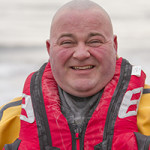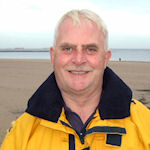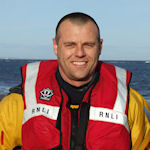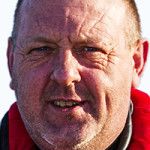History - Medals
On 19 January 1992 Leicester Challenge was launched into difficult sea conditions, an 11-13ft swell and onshore NW Force 5 wind, at 1314 to assist two persons cut off by the tide at the base of Huntcliff, over four miles ESE of the station. The lifeboat, with Peter Hodge at the helm and crew Derek Robinson, Barry Wheater and Mark Reeves, was lifted almost vertical by a wave as she was launched.
Leicester Challenge arrived on scene at 1324. The man, woman and dog were trapped beneath high cliffs with the incoming tide breaking all round them. They had moved onto high loose shale but their position seemed untenable. Seas were breaking directly onshore some 130 yards off. Peter took the lifeboat through the first line of breaking seas and turned head-to-sea to assess the situation. After consulting his crew, he told the coastguard he intended to attempt a rescue.
Peter turned the lifeboat to shore and ran in through heavy seas, using both engines and helm to control the lifeboat in such dangerous conditions. About 200ft from the cliff, the anchor was let go in l6ft of water. The engines were worked astern and, after a short distance dragging along the flat scar, the anchor held.
Peter veered down towards the casualties with crew members Mark Reeves in the bow and Derek Robinson taking soundings with a paddle over the stern. The lifeboat was constantly awash and at one point Mark, jammed into the bow to maintain his position, was engulfed in water. Around 50ft from shore, Derek touched the sea bottom with the paddle.
At this point, crew member Barry Wheater volunteered to swim ashore with a line tied around his waist. On reaching shore he made fast the line. The lifeboat was manoeuvred closer to shore, the engines were stopped and tilted clear to avoid damage from the rocks.
Derek went ashore with the stern line to assist Barry and to help prevent the lifeboat being drawn seaward. The seas lifted the lifeboat and pounded her against the rocks. At 1340 with Mark on the anchor warp and Barry and Derek ashore, Peter assisted the two survivors, Mr and Mrs Darling, and their dog Monty into the lifeboat. They were fitted with lifejackets and wrapped in foil blankets.
The crewmen ashore returned, the stern line was cut and the lifeboat was hauled, still grounding heavily, clear into deeper water. The engines were lowered and started, the anchor rope was cut, and the lifeboat was driven out through the surf.
At 1345, a Sea King helicopter arrived on scene from RAF Boulmer but, not being required, left the area. Peter set a course back to station and beached the lifeboat on the sand at Redcar. The survivors were landed at 1403 into the hands of waiting first aiders from the lifeboat station.
Peter Hodge was awarded the R.N.L.I.’s Bronze Medal for this service and Crew members Derek Robinson, Barry Wheater and Mark Reeves were awarded the Thanks of the Institution inscribed on Vellum.
In his official report, the deputy inspector of lifeboats for the East at that time, Tim Harrison, wrote that: (Peter) showed great leadership in quickly assessing the danger… courageously taking the lifeboat into heavy breaking seas… a truly excellent service and a great team effort which resulted in the crew coolly and professionally saving the casualties.
On Sunday 16 April 1995, two boys were seen in a dangerous situation at the foot of the cliffs at Saltburn. The Leicester Challenge launched at 1542 with Mike Picknett in command and Michael Hoyle, Barry Knaggs and Gordon Young as crew and headed at full power for the cliffs at Saltburn, some six miles away. As she approached the Coastguard Sector Officer on the cliff top showed the lifeboat where the two casualties were and Mike Picknett made a run past, clear of the surf line.
He saw the two boys standing on rocks at the foot of 500ft cliffs, just clear of the surf breaking on the rocks. There was still some one-and-a-half-hours until high water and, although the boys would probably still be clear of the water, they were already cut off and could not walk to safety. They were dressed only in shorts and T-shirts and would have to wait some hours before they could get to safety. The onshore wind was also forecast to in crease to Force 6.
After discussion with the Coastguard Sector Officer Mike Picknett decided to evacuate the casualties. By now the wind was NNW Force 4, with a substantial 2 to 3 metres Northerly swell rolling in onto the beach. Mike manoeuvred the lifeboat up-tide of the casualties and clear of the breaking seas, anchored and then veered down until they were about 60 metres from the shore, clear of some isolated rocks further inshore.
Gordon Young swam ashore with a line, two lifejackets and a waterproof VHF radio and secured the line around a rock. The lifeboat was now secured fore and aft but because Mike Picknett was worried that the engines might hit the rocks as the boat surged in the large swell the engines were stopped and lifted clear of the water. That done, Barry Knaggs also went ashore to help, and the two boys were soon put into lifejackets and, as they had arrived by mountain bike, they also put their cycle helmets on for extra protection.
The constant movement in the swell was causing the lifeboat to surge on the anchor warp and Mike Picknett dropped the port engine to help take the strain. However a very large sea struck the lifeboat, lifting her almost vertical, and as she fell back into the trough the port engine struck some submerged rocks. The lifeboat was resecured and the engine lifted to prevent further damage.
When the casualties were ready for the transfer the lifeboat was brought nearer and resecured about 30 metres from the shore. While waiting for a ‘smooth’ to make the transfer three 3 metres seas passed under the lifeboat, lifting her almost vertical again, and as she fell into the troughs her starboard quarter struck the bottom. However, once these had passed the first survivor was brought out to the boat.
Holding the boys firmly and reassuring them all the way, Barry and Gordon made their way out along the line through the surf to the boat. Barry took the youngest casualty out first and then returned to help with the second boy.
With everyone safely aboard the port engine was started, the anchor line and shore line cut and the Leicester Challenge was taken ahead until she was clear of the surf. The second engine was lowered and started and at 1625 she headed back to station.
Framed Letters of Appreciation signed by the Institution’s Chairman were sent to Senior Helmsman Mike Picknett and crew members Michael Hoyle, Barry Knaggs and Gordon Young following this service.
On 30 May 1999 both lifeboats were scrambled to the rescue of a man trapped by the rising tide beneath the 200 foot high cliffs at Saltburn. In a highly hazardous manoeuvre first the Atlantic 21 class lifeboat “Leicester Challenge” with three crewmembers aboard tried to approach the man through waves between 6 and 9 feet high. Eventually crewmember Tony Wild swam ashore with a safety line and a lifejacket for the survivor but before the man could be evacuated a series of very large waves caused the lifeboat to ground heavily.
At about the same time, with one propeller severely damaged, the other propeller became fouled on a loose rope in the water. Helmsman Mark Reeves performed tremendously well under the circumstances to coax the lifeboat to clearer water.
Having seen the problems encountered by “Leicester Challenge” the helmsman of Redcar’s D class lifeboat “Peterborough Beer Festival 1”, Mark Greaves and his crewmember without hesitation or regard for their own safety drove the smaller lifeboat through the breaking seas and onto the shore alongside the trapped man.
With a great deal of perseverance and determination the two lifeboatmen aboard “Peterborough Beer Festival 1” together with Tony Wild were able to evacuate the man after having been first thrown back onto the shore three times by the power of the waves, narrowly avoiding capsize on each occasion. The rescued man was then transferred to the “Leicester Challenge” for a more speedy and comfortable evacuation to safety at Redcar.
The efforts of all five lifeboat crewmembers were recognised by the RNLI Committee of Management with the presentation of Certificates of Commendation to each of them. The Chairman’s letter remarks that ‘…this was a well-executed service carried out in difficult conditions‘.




